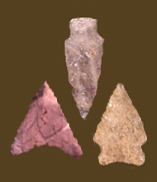
|
ST. ALBANS
The St. Albans point is long, narrow, and nearly shoulderless, with shallow side notches and a bifurcate base. Chronology The St. Albans point dates to the Early Archaic period, although some archaeologists, following Gardner (1989), see the introduction of bifurcate base points as the beginning of the Middle Archaic. McAvoy and McAvoy (1997) suggest a time span of 9000 to 8750 BP (approximately 8250-7850 BC in calendar years), based on points recovered in association with the Fort Nottoway/Big Sandy type along Virginia’s Nottoway River. Justice (1987) assigns a date range of 8900 to 8500 BP (8200-7575 BC), while Steponaitis (1980) suggests 8900 to 8600 BP. Broyles (1971) obtained radiocarbon dates of 6880 +/- 700 BC and 6870 +/- 500 BC (roughly 8000 BC in calendar years) for this type at the St. Albans site in West Virginia (she thought these dates were about 500 years too early, but dates elsewhere support them). Three dates from the Rose Island site in Tennessee clustered around 6770 BC (roughly 7750 BC in calendar years) (Chapman 1977). Broyles (1971) notes that the St. Albans type predates the LeCroy and postdates the Kirk Corner Notched. In the Northeast, some radiocarbon dates suggest that bifurcate base points could be 1500 to 2000 years younger than their equivalents in the Southeast (Funk 1993; Kent 1996). Description Blade: The blade is an elongated triangle with very weak shoulders, and has straight or excurvate sides which often exhibit slight serrations. The sharp tips can be slightly off-center. Re-sharpening can affect blade length, but the shoulder width appears to be maintained. Haft Element: The removal of two or three large flakes leaves the base notched, sometimes very deeply. Some examples have basal smoothing. On many examples, the point base is as wide as its shoulder. Side notches are long and shallow, and shoulders slope toward the tip. Size: Length ranges from 22 to 50 mm. Width ranges from 13 to 32 mm. Thickness ranges from 4 to 9 mm. Technique of manufacture: Soft percussion flaking, with pressure flaking around the basal notch and serrated blade. Material: In a sample of 22 St. Albans Side Notched points from the lower Patuxent drainage, Steponaitis (1980) reported that 64% were quartz, followed by rhyolite (32%), and quartzite (4%). In the area surrounding Zekiah Swamp on the lower Potomac, Wanser (1982) found that 74% of 93 St. Albans points were quartz, with 14% rhyolite, 5% quartzite, 4% chert, 1% jasper, and 1% other materials. In the Monocacy River drainage, 87% of 30 St. Albans points were rhyolite and 13% quartz (Kavanagh 1982). Chert and quartz St. Albans points predominate in the middle Potomac River Valley, but rhyolite, slate, and quartzite are also used (Hranicky 2002). In Western Maryland, St. Albans points are commonly made from local and non-local cherts, but rhyolite is also utilized (Wall 1991). In Delaware, bifurcate base points are commonly made from chert, jasper, and rhyolite (Custer 1996a). Discussion The stem of a St. Albans point does not lobe out to the side as much as the earlier MacCorkle stem, and it lacks the heavy basal grinding of the MacCorkle. The St. Albans point also has a narrower blade. Cresthull (1972b) stated that St. Albans points from the Chance site in Somerset County, Maryland had narrower stems and shallower basal notches than those found by Broyles. Defined in Literature References |
![]()
Search by Shape:
(See Projectile Point Typology) |

|
Thank you for visiting our website. If you have any
questions, comments, Copyright © 2002 by |

|

 Defining Attributes
Defining Attributes